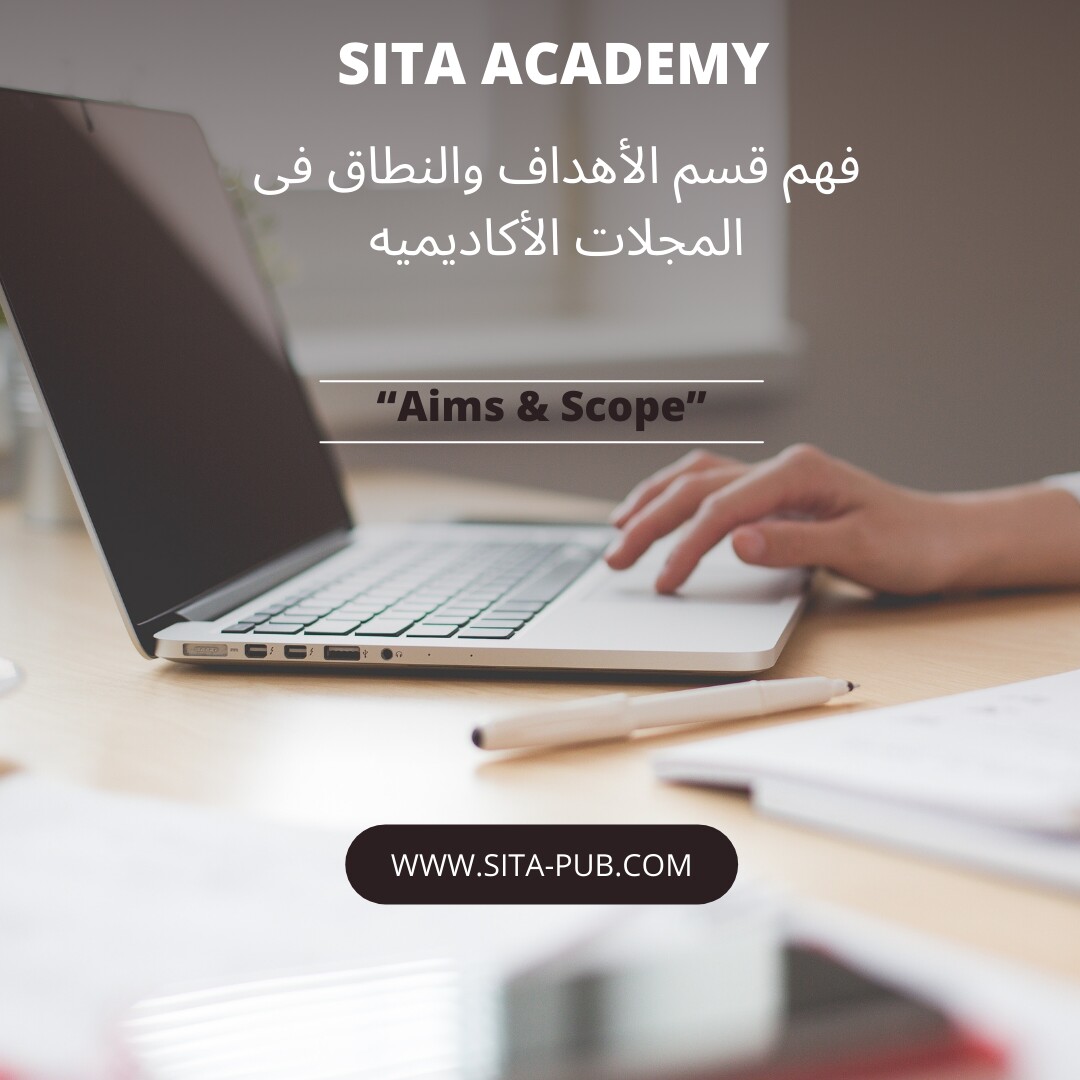فهم قسم الأهداف والنطاق (Aims and Scope) فی المجلات الأکادیمیه


قسم "الأهداف والنطاق" فی المجله الأکادیمیه هو عنصر حاسم یوضح ترکیز المجله وأهدافها وأنواع المقالات التی تسعى لنشرها. هذا القسم یعمل کدلیل لکل من المؤلفین والقراء على حد سواء، ویوفر وضوحًا حول ما تغطیه المجله والمجالات البحثیه التی تعطیها الأولویه. فیما یلی نظره فاحصه على أهمیه هذا القسم وکیف یؤثر على کل من المؤلفین والقراء.

إرشاد للمؤلفین: بالنسبه للباحثین الذین یسعون لنشر أعمالهم، یعتبر قسم "الأهداف والنطاق" أمرًا لا یقدر بثمن. فهو یساعد المؤلفین على تحدید ما إذا کان بحثهم یتماشى مع ترکیز المجله. من خلال فهم المواضیع والمنهجیات التی ترکز علیها المجله، یمکن للمؤلفین تعدیل مقترحاتهم بما یتماشى مع اهتمامات المجله، مما یزید من فرص قبول أبحاثهم.
تعریف هویه المجله: یساهم هذا القسم فی تحدید هویه المجله داخل المجتمع الأکادیمی. فهو یوضح مهمه المجله، سواء کانت ترکز على البحث النظری، الدراسات التطبیقیه، أو تخصص معین. یساعد "الأهداف والنطاق" الواضح المجله فی تحدید مکانتها بین نظرائها وجذب الجمهور المناسب.
تسهیل اکتشاف الأبحاث: یمکن للقراء الذین یبحثون عن مواضیع معینه الاستفاده من هذا القسم لأنه یوضح المجالات التی تغطیها المجله. هذا الوضوح یساعد الباحثین والممارسین والطلاب فی العثور على الأدبیات ذات الصله فی مجالات اهتمامهم.
المجالات الموضوعیه: عاده ما یذکر قسم "الأهداف والنطاق" المجالات الموضوعیه المحدده التی تغطیها المجله. قد تشمل هذه المجالات العلوم البیئیه، الهندسه، أو العلوم الاجتماعیه، بالإضافه إلى المواضیع المتخصصه التی ترکز علیها المجله.
أنواع المقالات: یحدد هذا القسم غالبًا أنواع المقالات التی تنشرها المجله، مثل الأبحاث الأصلیه، المراجعات، دراسات الحاله، أو الملاحظات الفنیه. یساعد فهم أنواع المقالات المقبوله المؤلفین على تنسیق أعمالهم بالشکل المناسب.
الجمهور المستهدف: قد تحدد المجلات جمهورها المستهدف، الذی قد یشمل الباحثین، الممارسین، صناع السیاسات، أو مجتمعات أکادیمیه معینه. تساعد هذه المعلومات المؤلفین على تخصیص أسلوب الکتابه والمحتوى لیتناسب مع الجمهور المقصود.
المنهجیات البحثیه: قد تبرز بعض المجلات المنهجیات البحثیه المفضله، مثل المنهجیات النوعیه أو الکمیه أو المنهجیات المختلطه. هذا التوجیه مهم جدًا للمؤلفین لضمان توافق أسالیبهم البحثیه مع توقعات المجله.
العلاقه مع عنوان المجله: من المهم ملاحظه أن عنوان المجله قد لا یعکس بشکل کامل "الأهداف والنطاق" الخاص بها. قد یشیر العنوان إلى ترکیز أوسع أو مختلف عما تغطیه المجله بالفعل، مما یجعل من الضروری للمؤلفین قراءه قسم "الأهداف والنطاق" للحصول على فهم دقیق.

المفهوم الخاطئ: یعتقد المؤلفون فی کثیر من الأحیان أن قسم "الأهداف والنطاق" هو مجرد إجراء شکلی ولا یؤثر بشکل کبیر على عملیه تقدیم الأبحاث.
التوضیح: قسم "الأهداف والنطاق" أساسی لمواءمه بحثک مع ترکیز المجله. تجاهله قد یؤدی إلى الرفض بسبب عدم التوافق.
المفهوم الخاطئ: بعض المؤلفین یفترضون أنه یمکن تقدیم أی بحث ذی صله إلى أی مجله طالما أنه یقع ضمن فئه واسعه.
التوضیح: کل مجله لدیها مواضیع ومنهجیات معینه تفضلها. فهم هذه الفروق الدقیقه أمر ضروری من أجل نشر ناجح.
المفهوم الخاطئ: قد یعتقد بعض المؤلفین أن قسم "الأهداف والنطاق" ثابت ولا یتغیر بمرور الوقت.
التوضیح: قد تقوم المجلات بتحدیث قسم "الأهداف والنطاق" لتعکس الاتجاهات الناشئه أو التحولات فی الترکیز الأکادیمی. من المهم مراجعه هذا القسم بانتظام من قبل المؤلفین والقراء.
المفهوم الخاطئ: یعتقد بعض المؤلفین أن عنوان المجله وحده یشیر إلى نطاق الموضوعات التی تغطیها.
التوضیح: قد یشیر العنوان إلى ترکیز أوسع مما هو مذکور فی قسم "الأهداف والنطاق". من الضروری دائمًا الرجوع إلى هذا القسم للحصول على معلومات مفصله.

اقرأ بعنایه: قبل تقدیم مخطوطتک، اقرأ قسم "الأهداف والنطاق" بعنایه. تأکد من أن عملک یتماشى مع ترکیز المجله ومعاییر التقدیم.
تعدیل مخطوطتک: إذا لزم الأمر، قم بتعدیل مخطوطتک لتتناسب بشکل أفضل مع أهداف المجله. قد یشمل ذلک تحسین أسئله البحث، تسلیط الضوء على نتائج معینه، أو تغییر الهیکل.
تحقق من التحدیثات: قد تقوم المجلات بتحدیث قسم "الأهداف والنطاق" بشکل دوری. تحقق دائمًا من أحدث نسخه لضمان أن بحثک یتماشى مع ترکیز المجله الحالی.
قسم "الأهداف والنطاق" فی المجله الأکادیمیه هو أکثر من مجرد بیان شکلی؛ إنه مصدر حیوی یشکل هویه المجله ویوجه المؤلفین فی رحلتهم نحو النشر. من خلال فهم هذا القسم، یمکن للباحثین تعزیز فرصهم فی النشر الناجح والمساهمه بشکل هادف فی مجالاتهم. دائمًا ما یکون من الضروری أن تأخذ الوقت الکافی للتعرف على "الأهداف والنطاق" لأی مجله تفکر فی النشر فیها - إنها خطوه حاسمه فی عملیه نشر الأبحاث.

إذا کنت تبحث عن مجله مناسبه تتماشى مع بحثک، نحن هنا لمساعدتک! تواصل معنا الیوم، وسیساعدک فریقنا فی العثور على المکان المثالی لنشر ورقتک.
إذا کان لدیک أی أسئله، استفسارات، أو ترغب فی معرفه المزید عن خدماتنا، فلا تتردد فی التواصل معنا. فریقنا المخصص مستعد لمساعدتک.